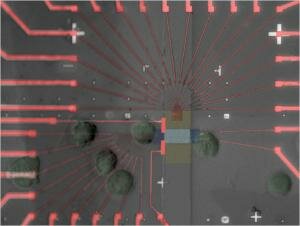Chemists Report The Creation Of Large-Scale Molecular Memory
A team of UCLA and California Institute of Technology chemists has created an ultra-dense memory device that stores information using reconfigurable molecular switches.
The 20 kilobyte memory device has a bit density of 100 gigabit per square centimeter and has enough capacity to store the Declaration of Independence with space left over.
The accomplishment represents an important step toward the creation of molecular computers that are much smaller and could be more powerful than today's silicon-based computers.
“Using molecular components for memory or computation or to replace other electronic components holds tremendous promise,” said J. Fraser Stoddart, who is the Fred Kavli Chair in Nanosystems Science at UCLA and director of the California NanoSystems Institute.
“This research is one of the only examples of building large molecular memory in a chip at an extremely high density, testing it, and working in an architecture that is practical, where it is obvious how information can be written and read.”
The memory is based on a series of perpendicular, crossing nanowires, similar to a tic-tac-toe board: 400 silicon wires crossed by 400 titanium wires, each 16 nanometers wide. Sitting at each crossing of the tic-tac-toe structure and serving as the storage element are approximately 300 bistable rotaxane molecules.
These molecules may be switched between two different states, and each junction of a crossbar can be addressed individually by controlling the voltages applied to the appropriate top and bottom crossing wires, forming a bit at each nanowire crossing.
“For this commercial dream to be realized, many fundamental challenges of nano-fabrication must be solved first,” Stoddart said with regard to Caltech's breakthrough. “The use of bistable molecules as the unit of information storage promises scalability to this density and beyond. However, there remain many questions as to how these memory devices will work over a prolonged period of time.
This research is an initial step toward answering some of those questions.”
“We have shown that if a wire is broken or misaligned, the unaffected bits still function effectively; thus, this architecture is a great example of 'defect tolerance,' which is a fundamental issue in both nanoscience and in solving problems of the semiconductor industry,” Stoddart explained. “This research is the culmination of a long-standing dream that these bistable rotaxane molecules could be used for information storage.”
“It's the sort of device that Intel would contemplate making in the year 2020,” says James Heath, who is the Gilloon Professor at Caltech. “But at the moment it furthers our goal of learning how to manufacture functional electronic circuitry at molecular dimensions.”
The 2020 date assumes the validity of Moore's Law, which states that the complexity of an integrated circuit will typically double every year, leading to a projection that the electronics industry will achieve a device density comparable to the memory circuit in about 13 years.
However, the Caltech-UCLA team points out in their report that manufacturers can see no clear way at present of extending this miniaturization beyond the year 2013. The new approach of the Heath team, therefore, will show the potential for making integrated circuits at smaller and smaller dimensions.
“Our goal was not to demonstrate a robust technology; the memory circuit we have reported on is hardly that,” said Heath. “Instead, our goal was to demonstrate that large-scale, working electronic circuits could be constructed at a density that is well-beyond 10-15 years where many of the most optimistic projections say is possible.”
“Molecular switches will lead to other new technologies beyond molecular electronic computers,” Stoddart said. “It is too soon to say precisely which ones will be the first to benefit, but they could include areas such as health care, alternative energy, and homeland security.”
Stoddart, his collaborator James R. Heath, the Elizabeth W. Gilloon Professor of Chemistry at the California Institute of Technology, and their research teams report the work in the January 25 issue of the journal Nature. The research was funded primarily by the National Science Foundation and the Defense Advanced Research Projects Agency.

"An ultra-dense 160-kilobit memory made up of a 400 x 400 grid of nanowires."

"Two-state rotaxane molecules act as switches."

"The memory chip placed among white blood cells for size comparison."
Source: National Science Foundation
|